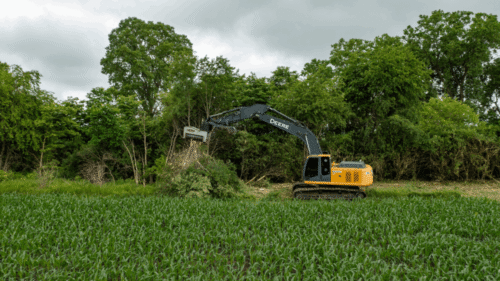If your tree is dead, diseased, or potentially dangerous, then you’ll need to remove it. However, removing a tree can be tricky if you don’t know what you are doing. Attempting it yourself can be dangerous so tree removal is best left to the experts. At Jim’s Tree & Stump Removal, we are highly experienced at safely and efficiently removing trees.
Our tree removal process
The process of tree removal can vary depending on the type of tree. As trees range in size, shapes and location, our removal process is adaptable so we can tackle even the trickiest removal jobs. Our team usually consists of four tree removalists and will include a climber, a backup climber, and two ground crew. We follow our trusted and proven seven step process when removing trees.
1. Assess the tree & environment
We begin our removal process by assessing the tree and its surrounding environment. This enables us to ensure the tree needs to be removed and prepare for any potential hazards or nearby obstacles. Common hazards and obstacles include telephone wires, difficult to access areas, and rotting tree branches. We also prepare the surrounding area for the removal. As tree removal can be unpredictable, it may be necessary to rope off the area and remove any cars or any other property which could be potentially damaged by falling trees or branches.
2. Set-up the necessary equipment
Depending on the size of the tree, we may need to scale the tree and use specialised equipment. Usually, a climber will scale the tree and set up the required lines. We will then set up all equipment including a wood chipper to remove green waste.
3. Begin to dismantle the tree via canopy and branches
The climber will use a chainsaw to remove parts of the tree and lower the segments to the ground crew below. The ground crew will then use the wood chipper to further break down the segments and other green waste.
4. Cut and fell remaining trunk
After the canopy and branches have been successfully removed, we move onto the trunk. There are two approaches depending on the tree size and surrounding area. In the case of larger trees in awkward spots, we chose the safer but slower option of cutting the trunk into sections and lowering them to the ground (similar to how we remove the canopy and branches). However, if it has adequate room and our team has conducted a safety assessment, we fell the remaining trunk. Felling is a tree removal technique that involves cutting the tree at an angle with a chainsaw and letting it fall to the ground. This technique tends to be one that amateur removalists gravitate towards and can be dangerous (occasionally deadly) if a tree falls the wrong way. Best leave this to the experts.
5. Dispose of remaining waste
Tree removal can be messy. At Jim’s Tree & Stump Removal, we ensure to dispose of all the remaining green waste including twigs, leaves, branches, and tree trunk by using a wood chipper. This green waste is turned into mulch which can then be used on your garden. By removing all the waste, we’ll leave your garden looking in better condition than we found it!
6. Assess & remove the stump
After removing and disposing of your tree, we may assess whether the remaining stump needs removal. Depending on the condition of the stump and your preference, we may begin the stump removal process. This follows a similar step process of cutting into sections, removing roots and grinding the green waste.
7. Perform a final inspection
We’ll perform a final inspection of the tree site and dispose of any remaining green waste.
Need more information?
If you have any questions on our removal process or would like to arrange an inspection of your trees, please get in touch with our friendly team. We are happy to answer any questions about the process, tree and stump removal, and tree maintenance.

